Belo Horizonte "Intelligent Mobility in Expresso Amazonas" project in review
The city of Belo Horizonte was founded in 1897, around 200 years after the discovery of gold in Brazil. It was located in a strategic location in the southeast region, well connected by roads to the coast and, therefore, to ports, facilitating the gold transportation to Europe.
Belo Horizonte was a planned city, inspired by the concepts of sanitation, and was born limited in its boundaries. The central urban area, with a reticulated layout, was limited by a ring road that was surrounded by a suburban area, which had the rural areas as its continuity.
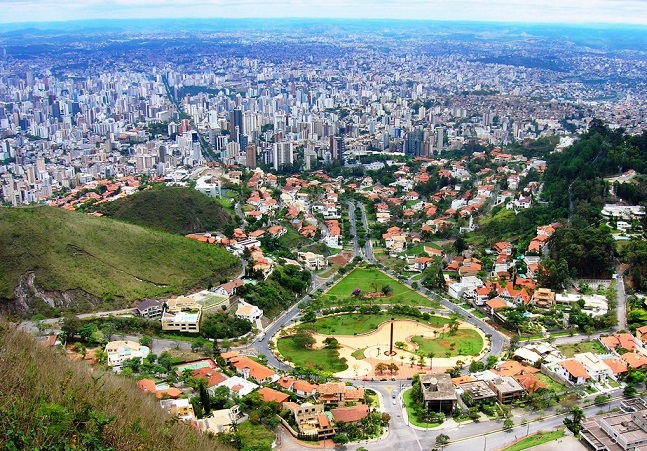
Landscape of Belo Horizonte. Photo by Marina Campos Vinhal
Years of uncontrolled growth brought significant impacts like informal settlements, occupation of slopes and riverbeds, sprawling and poor infrastructure, including transport. Today, the planned central area corresponds to only approximately 5% of the territory and in the 1950s it was already possible to notice a conurbation of Belo Horizonte with some neighbouring cities, nowadays part of the Metropolitan Region of Belo Horizonte.
GFCP Intervention
The Expresso Amazonas is one of the most important transport corridors in Belo Horizonte and connects the city centre with its metropolitan region to the west of the capital. Around 38 municipal bus lines (approximately 200,000 passengers) and 64 intercity bus lines (approximately 340,000 passengers) travel on this transport corridor, according to a survey carried out by the UK FCDO Global Future Cities Programme.
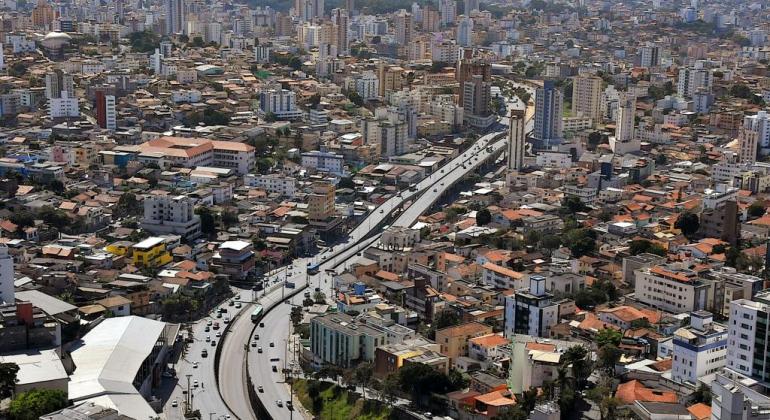 Belo Horizonte
Belo Horizonte
There is a steady increase in the flow of vehicles and the demand for public transport, as many residents work in the industrial area in neighbouring municipalities. In addition, a robust reurbanisation process is underway in the region, which is one of the poorest in the city, with irregular settlements, intense commerce, and universities.
Surveys on the origin and destination of passengers and, consequently, on their travel patterns, are based on samples of the population. Their updates tend to be slow in Brazilian cities because they are complex and expensive. These surveys are usually updated every 10 years and, considering the speed of changes in contemporary life, the structural planning of transport systems is already born obsolete in many cities.
Today, transport in urban buses is the only option to travel long distances in Belo Horizonte since there was no investment in the past in subway lines. Despite being the most used means of transportation by the population, the challenges are great since there is a lack of real-time data and evidence for anticipating problems and planning for a more efficient system.
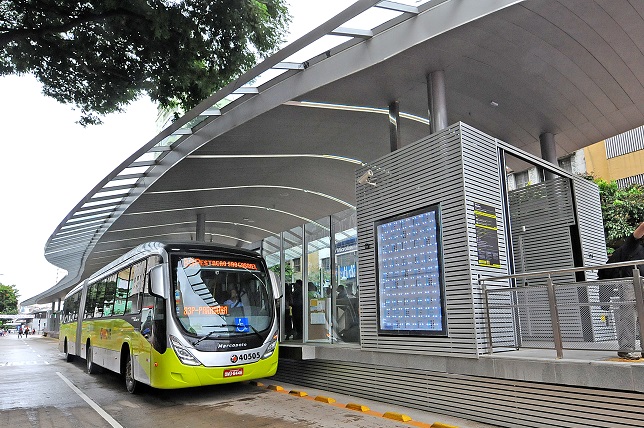
Belo Horizonte transport
To minimize the impacts of the lack of data and evidence for the improvement of transport planning, Belo Horizonte and the British Government established a cooperation through the Global Future Cities Programme for the implementation of an Intelligent Mobility Solution (IMS) - Intelligent Mobility in Expresso Amazonas (IMEA). The intervention aimed at improving the quality of service offered to transport users using technological solutions capable of providing the public transport company (BHTRANS) with a better understanding of the needs and travel patterns of passengers. It is expected that the works completed will result in more accessible and inclusive services, with benefits for urban planning, public safety, and environmental conditions in the city.
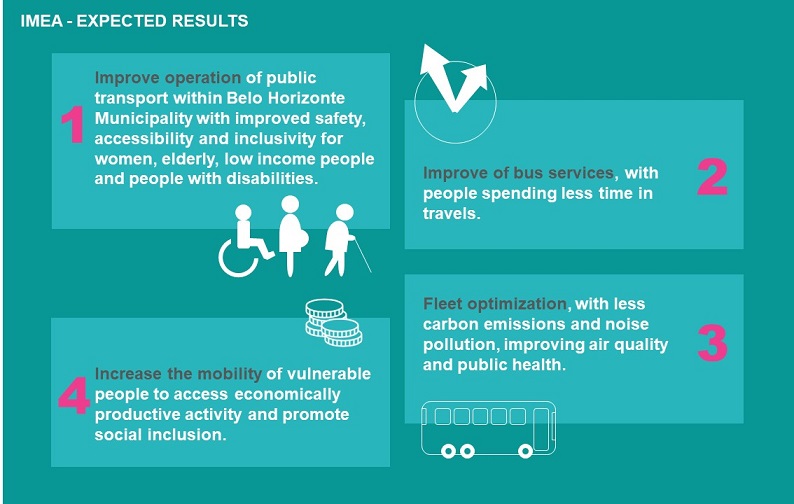 Project's long term expected results
Project's long term expected results
The UK Foreign, Commonwealth & Development Office cooperation fund covered a detailed scope design phase, developed by UN-Habitat, in 2018, and the implementation of services, under the leadership of the Ernst and Young (EY) consultancy, with collaboration of third parties such as ITDP and Being Co. The local working group included representatives from the Municipality of Belo Horizonte, through its Budget, Planning and Management Secretariat; the technical staff of the public IT company (PRODABEL) and technicians and specialists from the Public Transit and Transport Company (BHTRANS).
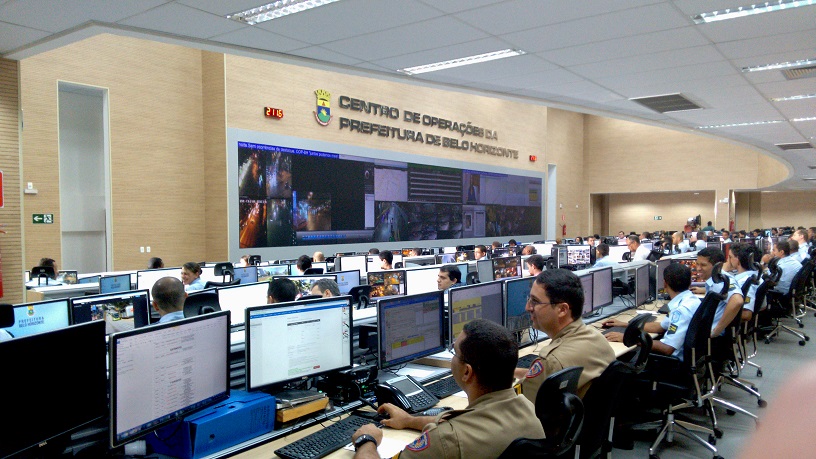 Belo Horizonte Centre of Operations
Belo Horizonte Centre of Operations
The 4-years project was successfully completed in March 2022. For the implementation of the project, 4 work stages were followed: Baseline Assessment, Mapping, Feasibility Assessment and Pre-Implementation. Each stage involved different activities, such as interviews and workshops, with the production of 15 reports, covering relevant content for the final implementation.
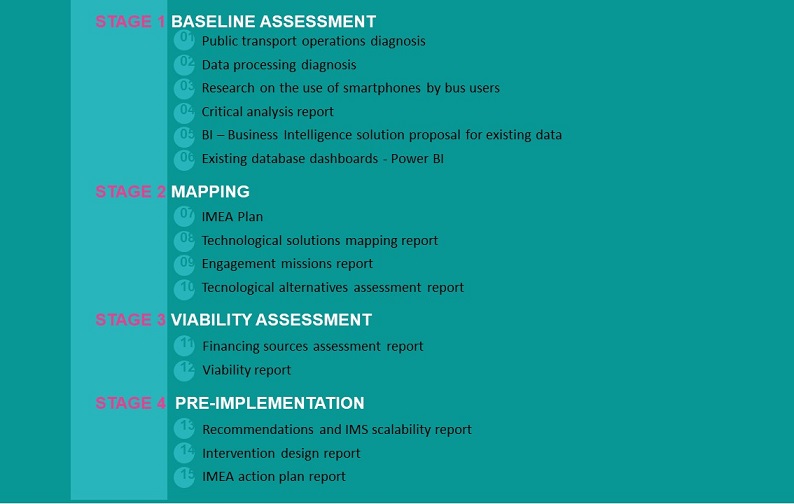 The four stages of the project
The four stages of the project
Stage 1: Baseline Assessment
01 Diagnosis of Public Transport Operations on Avenida Amazonas
Overview of public transport operations – municipal and intercity – on Avenida Amazonas. Particular attention is paid to the socioeconomic profile of the resident population and public transport users in the area of influence, in addition to their mobility patterns.
02 Data Processing Diagnosis
Systemic architecture scenario and data related to the city's transport system, focusing on Avenida Amazonas. Mapping of the technological resources involved in the administration of the transport system, highlighted potentialities in the availability of data and in the systemic integrations.
03 Research on the use of smartphones by public transport users on Avenida Amazonas
Research on the contribution of Information and Communication Technologies in the planning and management of public transport to make it more effective and inclusive. Research on the profile and perception of public transport users and how they use mobile devices.
04 Critical Analysis Report
Analysis of project objectives related to Smart City concepts and the UN Sustainable Development Goals. Measurement of the maturity level of the city of BH for ITS systems, capacity building plan for future technological needs and evaluation of how the technology can benefit different passenger profiles.
05 BI Solution Proposal – Business Intelligence for existing databases
Proposal of the Business Intelligence plan to help in planning the public transport system in Belo Horizonte. Mapping of the current situation and future perspectives, and training plan in Business Intelligence for local technical teams.
06 Dashboards with the existing bases – Power BI
Interactive dashboards using existing databases.
Stage 2: Mapping
07 IMEA Plan
Components initially suggested to structure the development of the plan. Presentation of the objectives associated with each component, preliminary proposals for goals and indicators for monitoring the results, and potential technological solutions.
08 Technological Solutions Mapping Report
Mapping of alternatives for technological solutions, to assist the public administration of Belo Horizonte in defining the most relevant solutions for the implementation of IMEA-BH.
09 Engagement Missions Report
Selection process of smart mobility solutions and suppliers to carry out Proofs of Concept. Selected Brazilian and international companies presented their cases of technological solutions.
10 Evaluation Report on Technological Alternatives
It preceded the Proof of Concept and aimed at the evaluation, classification and, finally, the selection of technological solutions to be tested. Solutions evaluated based on criteria defined from the expected impacts of the project and the city's data operations.
Stage 3: Viability Assessment
11 Financing Sources and Opportunities Assessment Report
Identification and evaluation of several possible sources of financing for the solution and the most appropriate ones according to the objectives of the Project.
12 Feasibility Report
Presentation of the technological solutions evaluated and chosen to be tested in the Proof of Concept. Analysis and conclusion under technical, financial, legal, data governance and risk aspects. Results compared to the goals defined in the IMEA Plan.
Stage 4: Pre-Implementation
13 IMS Recommendation and Scalability Report
Results of the Proofs of Concept and feasibility of the application of each technological solution. Indication for improvement measures for the data processing phases, based on the data life cycle. Mapping of suggested key components and key drivers for hardware and software.
14 Intervention Design Report
Specification of each component of the Global solution architecture and roadmap for implementing the solution, containing stages of process changes and necessary activities. Presentation of standard operating procedures, risks involved, and impacts of the solution related to gender and social inclusion.
15 IMEA Action Plan Report
Recommendations for opening the Global Solution procurement process, containing steps for the acquisition process and quantity of necessary components with their estimated values. Guidance for the development of a supplier evaluation matrix, considering values and technical aspects. Metrics and KPIs established for monitoring impacts.
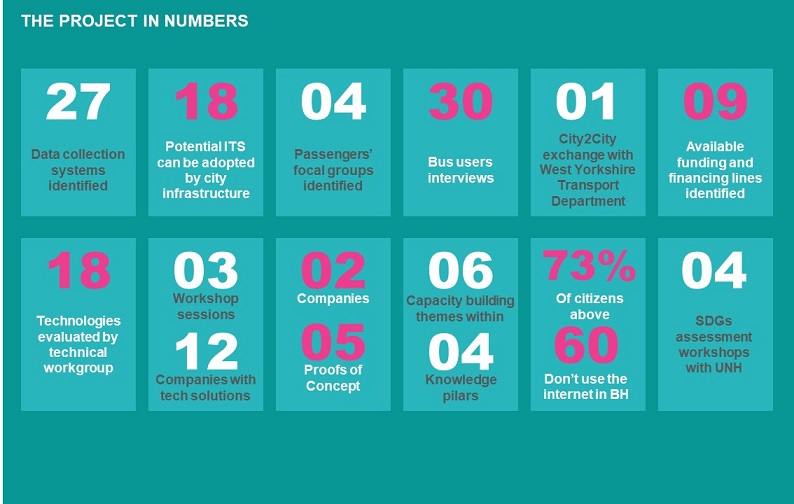
Belo Horizonte – Intelligent Mobility in Expresso Amazonas (IMEA) project in numbers
Next Steps
The recommendations of the final project report focused on the design of a roadmap for the continuity of the work beyond the period of the cooperation agreement between the British Government and the Municipality of Belo Horizonte.
Among the main steps for the complete implementation and scalability of the IMS in Belo Horizonte, the following stands out:
- Definition of responsibilities for the project
- Confirmation of the architecture of the system and its components
- Preparation of the bidding process
- Choice of service provider(s)
- Contracting services
- Execution of the Implementation Plan and necessary training
- Monitoring of impacts
- Execution of the system scalability strategy
Special thanks
On behalf of the Global Future Cities Programme team, I would like to thank everyone who has contributed to the realization of this incredible work developed so far. To the EY team, who were restless to move forward to ensure the smooth pace of work in the midst of the pandemic, and who exceeded our expectations with invaluable technical contributions and recommendations.
Thanks to the UN-Habitat team who supported the FCDO in monitoring the SDGs and Capacity Building sessions with UKBEAG, bringing the 19 cities around ONE Global Future Cities Programme. Special thanks to the Belo Horizonte working group, which involved people from different areas to bring their impressions, perspectives, and expectations to take the most from this partnership. I look forward to seeing the next steps of this project put into practice by this extraordinary group, committed to the well-being of its citizens.
After 4 years of intense work, I will miss all the interactions, conversations, and discussions. I will take the learnings from each one of you, and my admiration and respect will remain.
Belo Horizonte is part of a group of 19 cities around the world chosen by the UK FCDO Global Future Cities Programme (GFCP) for a partnership in sustainable urban development. In Belo Horizonte the UK fund is helping to promote better transport planning in the City.
Partner
Ernst and Young (EY)
Country
Federative Republic of Brazil
City
Belo Horizonte
Themes
Social Inclusion
Mobility
Data Systems
Author(s)

Adriana Figueiredo
Global Future Cities Programme Manager, Brazil UK FCDO